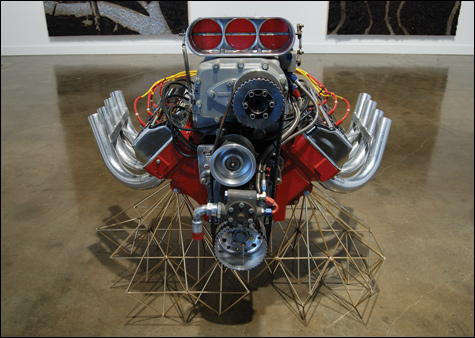Kara Walker's 2005 shadow-puppet video 8 Possible Beginnings: Or, the Creation of African-America: A Moving Picture by Kara E. Walker is a haunted fantasia chewing over the history of African-Americans. Sailors throw black captives overboard from a slave ship. An island, which rises up as a black giant, swallows the bodies. A black man picks cotton, then dances with a Colonel Sanders type. They wind up naked, with the white guy sucking the black man's cock and then stuffing cotton up the black man's ass. The black man grows pregnant and births a cotton sprite. The white guy lurks in pursuit of a little black girl. A little white boy forces Uncle Remus to tell him a story. Uncle Remus tells of Br'er Fox and Br'er Rabbit lynching black men from a tree.

HEART OF PROMETHEUS: Matthew Day Jackson’s commission from “Big Daddy” Don Garlits typifies the vogue in middle-class guy taste. |
Walker's animations are a natural evolution of her terrific 19th-century-style paper-cut silhouette works. I prefer the paper stuff. Her static works are beautiful, brutal, suggestive, open-ended, alluringly mysterious tales of black and white in America, often shot through with a discomforting sexual charge. Her films make her points as explicit as bathroom graffiti, thereby closing off possibilities.
Charlie White's 2006 color photo 1957 re-creates the atmosphere of '50s white kids hanging around with cars à la George Lucas's 1973 film American Graffiti. A young black woman, in the background, walks out of the picture, her stance quoting the iconic photo of 15-year-old Elizabeth Eckford being turned away from the segregated Little Rock Central High School in 1957. That fleeting glimpse suggests the blind spots required to believe these were all happy days.
Cynthia Norton's Dancing Squared features four red-and-white patchwork dresses hanging from the corners of a small metal carousel. When the carousel rotates, the dresses spin, and a disco ball on top glitters. It's like watching prototypes for robot Dolly Partons. It doesn't feel deep, but it's a hoot to watch.
The show also includes Greta Pratt's photos of Abraham Lincoln impersonators, Eric Beltz's detailed, potty-mouthed drawings of the Founding Fathers, Barnaby Furnas's expressionist paintings of Civil War carnage as action films with red paint splashed everywhere, Sam Durant's creepy mannequins of good Native Americans and evil Pilgrims (said to have been acquired from the Plymouth National Wax Museum in Massachusetts when it was going out of business), and Brad Kahlhamer's swirling-all-over cartoon drawings of Native American life as depicted in Indian ledger books and in movies.
American history, legend, folk art, and artifacts are some of my favorite things — and maybe that's why I left feeling let down. Kilgallen and Walker can be excellent, but more than half the show feels up-tight, arch, festooned with postmodern footnotes. There's not enough of the astonishing, disconcerting, wildcat spark of folk and commercial art that the works draw on for inspiration. Instead we get knockoffs of vernacular art or artifacts that reinforce the old hierarchies of high and low. The nadir is Deborah Grant's insulting ripoff of folk artist Bill Traylor, whose work I love. I stared at Grant's and wondered, why not just include the real thing?